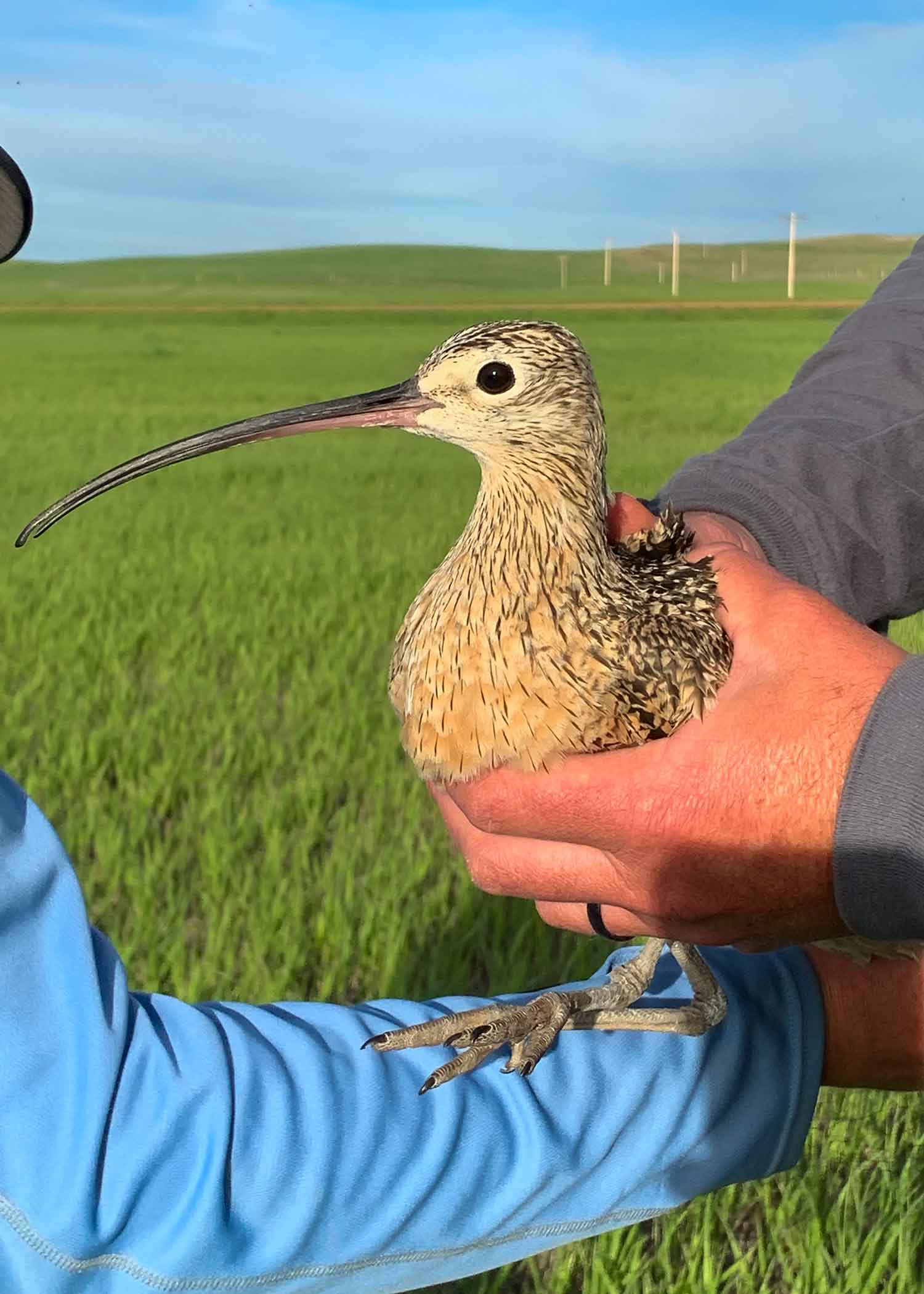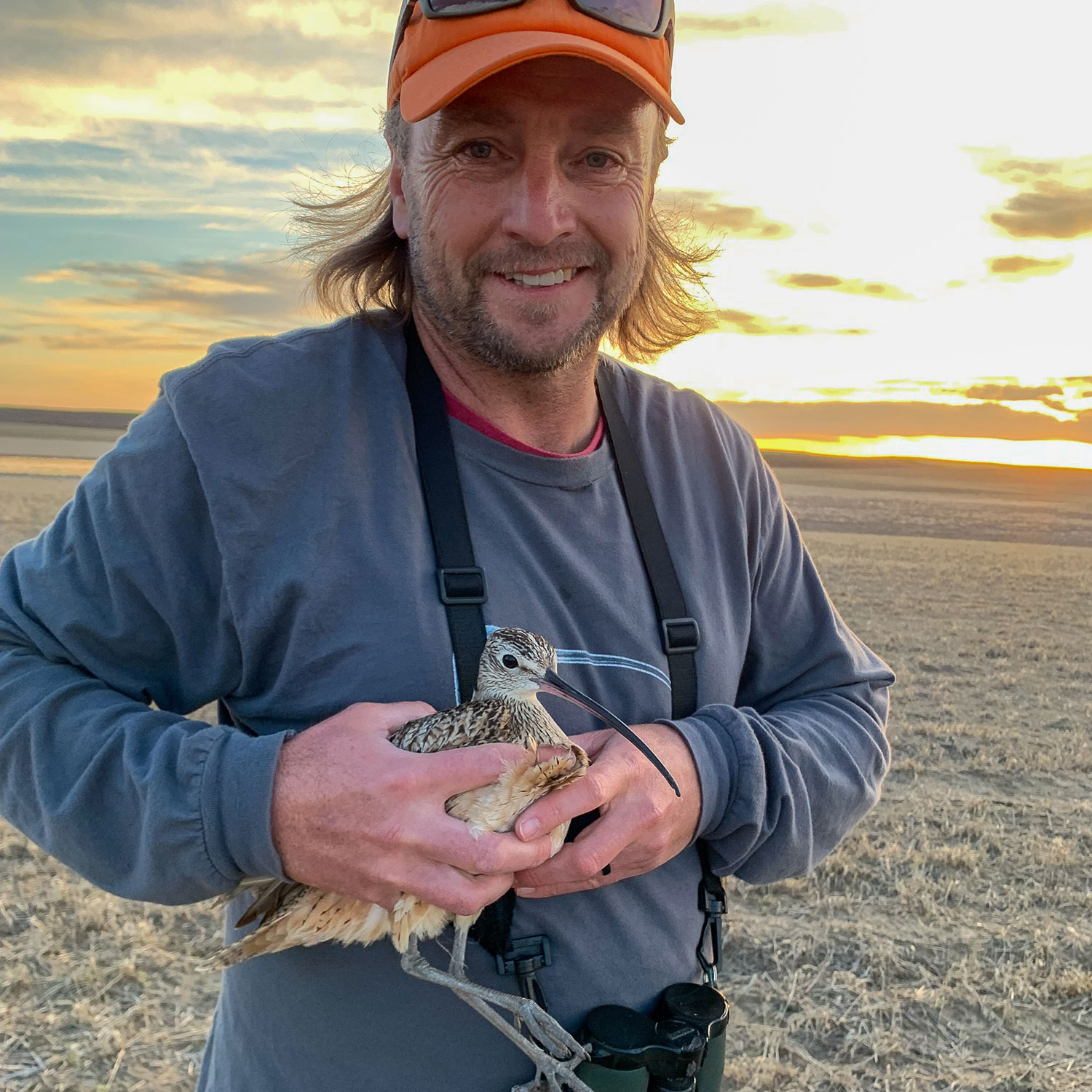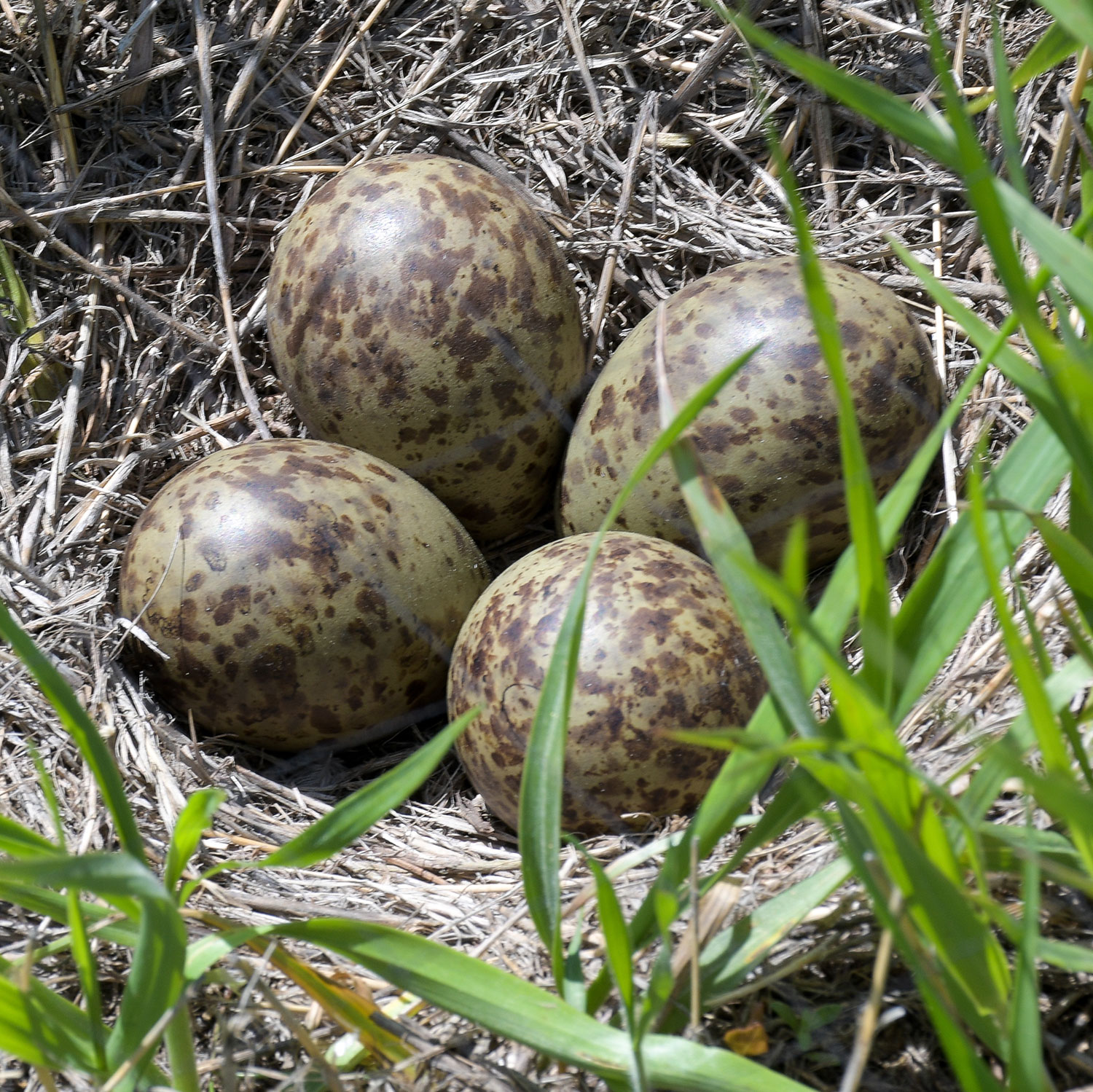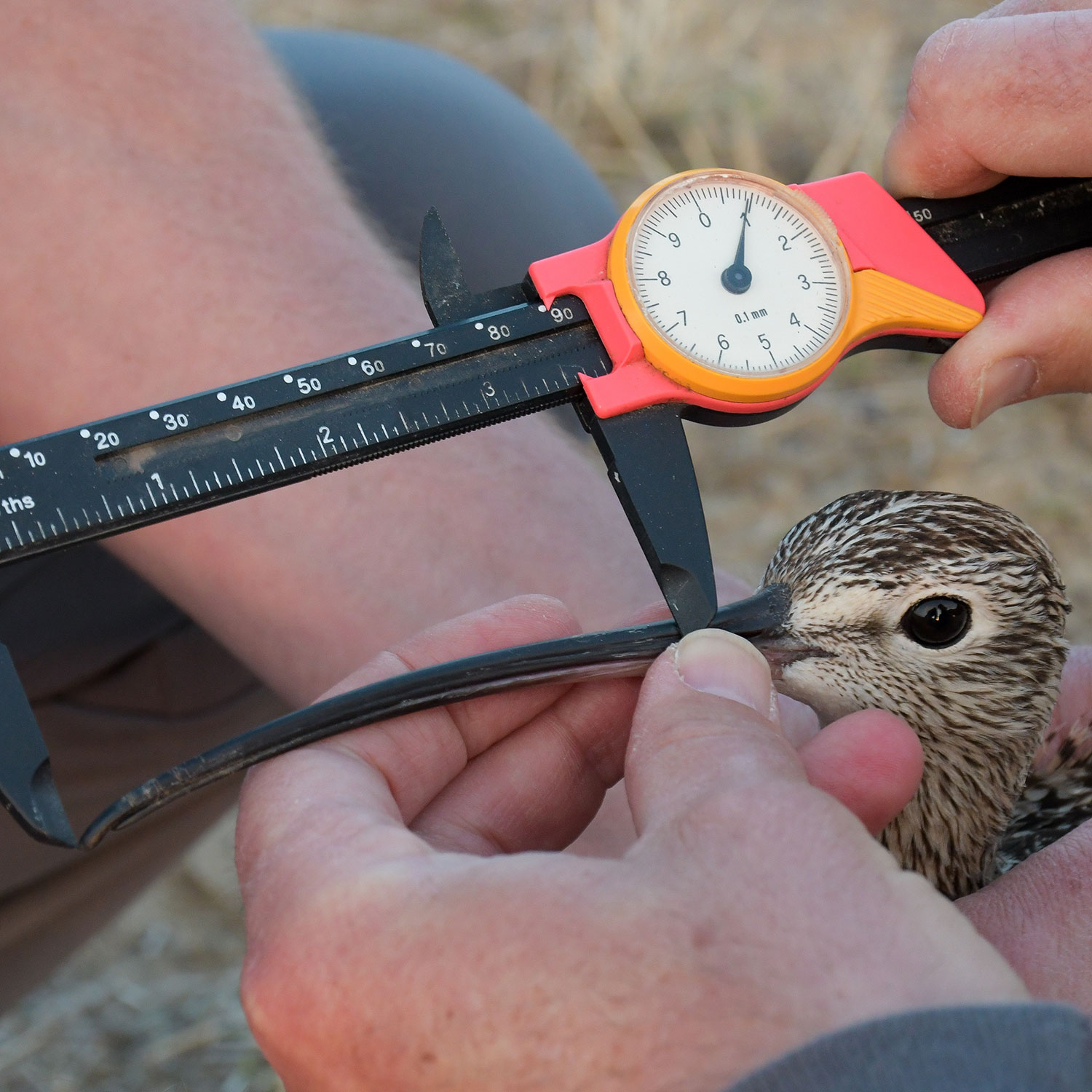Curlew Study
Ron Wilson

The North Dakota Game and Fish Department has teamed with two leading conservation organizations to study the movements of a conspicuous shorebird to better recognize the bird’s habitat use in southwestern North Dakota and elsewhere.
In the Department-funded study managed by Boise State University’s Intermountain Bird Observatory and Northern Great Plains Program of American Bird Conservancy, researchers planned to fit long-billed curlews, that migrated in spring to North Dakota to breed, with solar-powered tracking devices.
“We’re hoping to be able to find some curlew nests and then be able to trap adult birds and outfit them with satellite or cellular transmitters that can give us data remotely,” said Jay Carlisle, research director for Intermountain Bird Observatory. “Then we can just be armchair biologists and collect data on their movement throughout the year. The main goal is to get information on habitats and regions that are important to curlews, not just while they're here in North Dakota, but during migration, during the long non-breeding season and then spring migration again.”
Kevin Ellison, program manager for Northern Great Plains Program, said the goal was to fit five curlews nesting in North Dakota with transmitters and an additional four to five in South Dakota.
“Sometimes you can get lucky and get most of it done in two days, or it can take up to nine days or so, depending on the weather,” Ellison said. “We have a bunch of local staff and volunteers we can rotate through. American Bird Conservancy employs some local staff based out of NRCS offices, both in Miles City, Mont. and nearby Buffalo, S.D. who are able to come here and help out.”
While the long-billed curlew is North America’s largest shorebird, roughly the size of a sharp-tailed grouse, but on stilts, finding these birds in big, open, grassland country has a needle-in-a-haystack feel to it. Tougher yet, is finding a well-hidden nest occupied by an incubating adult secure enough in its hiding ability to let researchers tiptoe in and capture it.
The best chance for finding a nest is in the morning or evening when the birds switch incubation duties. Carlisle said, in general, males incubate from, say, 6 p.m. until 7:30 or 8 a.m.
“And then the female, who has been off the nest all night, returns to the territory, maybe feeds a little bit and then switches onto the nest. And then the male has the day to feed and be on patrol and then he’ll switch back on in the evening,” he said. “So, we have the most success being on site by sunrise and watching for those first 2 or 3 hours of the day hoping to catch a single female switching with a male onto the nest.”
Or researchers can do the reverse and spy a nesting site in the evening when the male returns to switch duties with the female.
Once researchers locate a nest, they sneak to the nest site carrying an 18-meter mist net parallel to the ground, with someone directing from behind, then drop the net on top of the incubating bird.
“Oftentimes, they actually stay until you approach them and then they'll jump into the net. Sometimes as you're arriving, they’ll flush and you miss them,” said Carlisle who has helped capture more than 100 curlews. “Then we detangle them as quickly as we can and move usually at least 200 meters from the nest to be able to do all the processing and put a band on the bird, take measurements, and then finally put on a satellite transmitter with a harness.”
Researchers describe curlews as a generalist species as they aren’t as picky as to where they construct their nests. From grasslands to stubble fields, to a pasture next to a cowpie, these birds adapt.
“They're probably looking and responding to fewer conditions than some of the pickier species that we affectionately call ‘Goldilocks’ species that have to have it just right,” Ellison said. “Some of the pickiest species are like pipits and longspurs that nest at higher densities in native grass. So, you range from species that are really adaptable and generalist to really specialized and the curlew is a little more on that generalist side.”
So, why study long-billed curlews as many other species, ones that researchers know by song or simply by glancing at as they wing speedily by, share much of the same landscape?

Researcher Jay Carlisle with the aptly named long-billed curlew, North America's largest shorebird.
“Long-billed curlews are a species of concern because of population declines, and they’re also seen as an indicator species for the health of grasslands, even agricultural lands,” Carlisle said. “Mainly it's because of this population decline that has happened disproportionately in different areas, that there's been interest in understanding more about the full annual cycle of long-billed curlews and ideally stitching together what are some limiting factors, what are some threats that affect populations and are they affecting different populations differently? We already know this is the case, but we’re still learning more and more about different populations.”
Ellison said studying curlews comes back to the understanding that everything is connected, and conservation doesn’t happen on its own.
“These birds are great indicators of ecological health. Their position in food chains and their lifespan is pretty short, so they can help us see how healthy our environment is,” he said. “These are working lands here in North Dakota and we're just looking at how we can have all the pieces work together.”
Carlisle said that while researchers would prefer to get a 50-50 sample size when trapping curlews and outfitting them with tracking devices, in the end it really doesn’t matter.
“I honestly don’t remember how many pairs we’ve tracked now, at least 10, and never have the two individuals migrated to the same wintering site. They always go to different sites, say, at least 50 or 100 miles apart, sometimes many hundreds of miles apart,” Carlisle said. “And, yet somehow they easily find each other again in the spring. It’s like, ‘Oh, hey, it’s you. How was your winter?' And they probably don't need any courtship.”
Sandra Johnson, Game and Fish Department conservation biologist, said the hope is that the study will reveal a full lifecycle perspective on these interesting birds.
“Long-billed curlews are only in North Dakota for a couple of months during the breeding season and then they migrate to the Texas coast or elsewhere for seven, eight, nine months,” Johnson said. “So, it’s really important to learn more about whether we are all doing our part to make sure that this bird has safe places all along the way.”
The long-billed curlew has some history in North Dakota, Johnson said, as the bird was mentioned in Theodore Roosevelt’s journal.
“It’s a bird he observed when he was here in North Dakota, when he spent time on the Elkhorn Ranch, he called it one of the most conspicuous birds. It was a bird he really enjoyed. And it’s a bird that you probably can't find in that Elkhorn Ranch area anymore,” she said. “We still have a good curlew population in North Dakota, but there are places where we're just not finding them. So, that's where the study will really help figure out what's going on with our curlews.”

The solar-powered devices fitted to the study birds will provide tracking information for more than a year to researchers.

Long-billed curlew eggs, like the birds, are big. Bigger than a chicken will lay.

Researchers measure the length of the bill of a long-billed curlew captured in a mist net.
